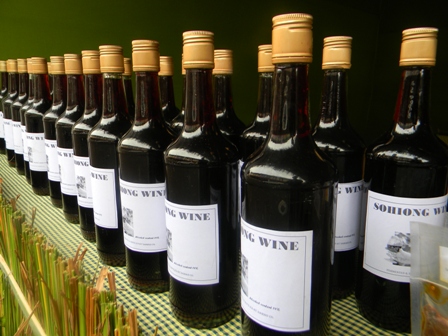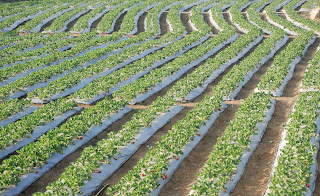- Syiem, Bary & Shabong, C.S.
 |
| Smt. Quency Thangkhiew at her Anthurium Greenhouse |
Floriculture was a passing hobby practiced by flower lovers and enthusiasts and Meghalaya is no exception. The people of Shillong were known for their passion with flowers which adorn their verandah and in lawns of prominent houses in Pine city. However in early 2000, availability of improved planting materials, seeds and other scientific, technical inputs and the increasing market demand, has encouraged growers to exploit the commercial potentialities of this hobby. As one hobbyist in Shillong remarked “this hobby of mine has now become a self paying venture due to the increasing awareness by housewives on this art”. Smt. Queency Thangkhiew, one of the earliest enthusiasts has turned this hobby into a thriving commercial enterprise. Thanks to such entrepreneurs, floriculture is now here to stay and Meghalaya is set to witness a colourful revolution in the days ahead. Thanks to the vision of the State Government to turn Meghalaya into a flower State of India, with the active support and participation of such brave entrepreneurs, the future is rosy indeed.
Commercial floriculture is a recent phenomenon in Meghalaya, promoted and assisted by the Government of India Scheme “Technology Mission Scheme on Horticulture”. Considering the natural advantages that the State is endowed with and the varied range of agro-climatic conditions available, there is high potential for cultivation of all types of flowers. The rich flora and the many species of orchids growing wild in the State, which is the highest ever recorded in a single concentrated area, is a testimony to this fact.
Meghalaya also has a very high potential for commercial floriculture due to the many competitive advantages the State has: a favourable climate, diverse agro climatic situations suitable for tropical and temperate flowers, competitive labour cost, proximity to Guwahati and Kolkatta Airport etc. The State is divided into 2(two) major floriculture zones namely; the temperate zone and the sub-tropical zone. The entire East and West Khasi Hills and the upper parts of Jaintia Hills district falls under temperate zone while Ri-Bhoi and the Garo Hills falls under the sub-tropical zone.
Floriculture produce, being a non food crop, was not a thrust area in the overall agriculture development plan of the State till the late 1990’s, where the thrust was on increasing food grains production and productivity. It was in 1993-94 that the Department of Agriculture started to popularize floriculture among flower growers and enthusiast through Government of India scheme. The Agri-Horticultural Society, Shillong aided by the Department of Agriculture also organizes flower show and flower competition in Shillong to promote floriculture. This became an annual event and has brought a lot of awareness to the public about modern floriculture practices and marketing prospects.
 |
| Commercial Carnations growing under Greenhouse in Nongstoin Horti Hub |
Further, with the establishment of a separate Directorate of Horticulture in the State, floriculture got a boost through the various schemes of the State Government like Development of Floriculture Scheme started in 2000-2001, Setting up of Model Floriculture Centre, Establishment of Floriculture projects at Dewlieh in Ri-Bhoi and Samgong Horticulture Farm in E.Garo Hills districts through the Technology Mission Scheme on Horticulture. The objectives of the schemes were to focus on the promotional and awareness aspects by providing incentives to the farmers and motivating them to grow traditional as well as non-traditional floral crops and houseplants for commercial purpose. The nature of assistance provided is in the form of providing the growers with diseased free planting material, organic/inorganic fertilizers, plant protection chemicals, garden tools and implements for a minimum area of 2000 square meters, along with a package of practices for commercial production. Each unit is envisaged to serve as a demonstration model for which the Department provides technical guidelines through extension and training. Crop selection is on the basis of existing popularity and market demands. A few of the recommended ornamental crops grown are Orchids, Chrysanthemums, Gerberras, Carnations, Liliums, Strelitzia reginae, Gladiolus, Asters, Marigolds, Statice, Gomphrenas, Helichyrsums, Zinnias, Roses and different kind of house plants etc. The concerted effort of the Department in motivating growers as well as providing infrastructural support in the form of green house, poly house, shade nets and other inputs has led to the establishment of a number of private nurseries especially in the East Khasi Hills district.
The Directorate of Horticulture has also identified floriculture clusters in the State which are suitable for growing certain high value flowers. East Khasi Hills have been identified for Orchids, Carnations and Gerbera; West Khasi Hills for Carnations; Jaintia Hills for Bird of Paradise; Ri-Bhoi for Orchid, Rose, Anthurium, Lilium and Foliage; West Garo Hills for Liliums and Bird of Paradise; East Garo Hills for Anthurium, Foliage and Bird of Paradise. At present, East Khasi Hills, East Garo Hills and Ri-Bhoi districts have established green house floriculture units in the departmental farms as well as in farmer’s field. The estimated area under floriculture in the State is about 500 Hectares.
The Rose Pilot project which was initially started at Dewlieh Departmental Farm in Ri-Bhoi district at an area of 0.5 hectare has been a success with a production of 2500 cut flowers per day. Today, Rose, Lilium and Anthurium cultivation has also been extended to farmer’s field in village clusters through self help groups and individual farmers.
The Anthurium project at Samgong Horticulture farm is a tourist spot for farmers, high power dignitaries and the common people. This is because of the success of the project taken under the cultivation of the flower. The excellent marketing of anthurium as cut flower gives a phenomenal impact to the farmers which encouraged them to go for commercial group cultivation.
Commercially, there are several existing limitations in the floriculture development in the State, which needs to be overcome through proper planning and developmental efforts at all levels. However, from a technical point of view, the development of floriculture business enterprises in Meghalaya has a very high potential. This potential can be exploited to improve the socio-economic condition of the State. In addition, being a major export item, it can substantially contribute towards foreign exchange earning of the entire country.
The India Today ranking of States in India has shown Meghalaya’s agriculture to be faring comparatively better among the Small States in North Eastern Region and the magazine ranked Meghalaya comparatively better. The State has also improved from its earlier overall 5th position during 2006 to becoming 1st among North Eastern States (except Assam which is categorized as a big State) during 2007. This goes on to show that agriculture, specially horticulture in Meghalaya is on a growth trajectory and the State only needs a boost in resources, better post harvest management, marketing linkages, organized marketing and creation of economy of scale in order to accelerate it to the take off stage. With the right policies of the State Government and adequate fund injection through the Technology Mission for Horticulture Development along with farmer’s and entrepreneurs of the State coming forward to take up commercial floriculture, Meghalaya will not be lagging behind and the vision articulated by the Department of Agriculture will hopefully, flower and bloom in its full glory and beauty.
(The writers are Agriculture Information Officer and Agriculture Development Officer, respectively working in the Department of Agriculture, Meghalaya)


